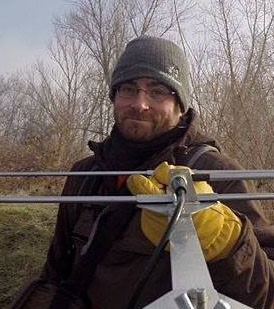David GRIMARDIAS, Ph.D.
Research Associate
david.grimardias@hesge.ch
+41 (0)22 546 68 71
http://cv.davidgrimardias.com

synopsis
After university education focused on biostatistics, population ecology and (eco-)ethology (at Claude Bernard Lyon 1 University, France), working primarily on amphibians dispersal, I was graduated with a Ph.D. in ichthyology and behavioural ecology in the University of Pau and Pays de l’Adour (France). My thesis aimed to understand how spawning habitat heterogeneity may influence the hierarchy among Atlantic salmon spawners, and hence the success of alternative reproductive tactics. Then I have been hired at hepia Geneva as research assistant (post-doctoral position) on a research project focused on the ecology and conservation of European grayling Swiss populations. I officiate since then as research associate in the same institute, focusing on the conservation and management of fish populations facing anthropogenic alterations of their environment, from individual behaviour investigations to long-term monitoring of communities. In this aim, many collaborative research projects are developed and carried out with local and federal environmental managers, hydropower producers, public institutes and private offices, as well as local environmental actors or fishing associations.
main research
As ichthyologist and behavioural ecologist, my current research activities mainly focuse on the ecological connectivity in riverine ecosystems, in relation with damming, for fish populations/communities. My research fields gather around these main topics:
- Impacts of hydropower production on fish migration/movement:
- Ecological connectivity and quantification of fish passage over dams: freshwater fish migration and how dams obstruct it; evaluation of fishways effectiveness for upstream and downstream passage.
- Fish behaviour in vicinity of dams: behavioural monitoring of fish for a better understanding of fishways use and effectiveness; path selection for fish passage.
- Impacts of sediment management practices in running waters: impact assessment of sediment flushing in hydropower reservoirs, from fish community in the reservoir facing water level lowering and hydraulic consequences to community downstream of the dam facing sediment release; comparison of sediment removal strategies.
- Conservation and management of fish resources in hydropower reservoir: biomass evaluation of fish community in lentic ecosystems; inter-seasonal and inter-annual variations; spatial variability; development of methodologies for hydropower reservoir monitoring (in close collaboration with J. Guillard, National Institute of Agricultural Research, France).
- Role of environmental variables in spawning/early life stage habitat use: role of heterogeneity of spawning habitat in reproductive success for alternative mating tactics (Salmo salar, Ph.D. research); riverbank habitat selection and dispersal in fry of European grayling Thymallus thymallus; Spawning habitat selection in lake trout Salmo trutta morpha lacustris.
Finally, as research associate in an applied sciences university, I am also deeply interested in methodological development in wild freshwater fish populations monitoring, in order to better evaluate processes and impacts and provide effective ecological recommendations for their conservation to hydropower producers and environmental managers.
KEYWORDS: Behavioural ecology, conservation, ecological connectivity, hydropower dams, telemetry
external responsabilities
Reviewer for :
- Journal of Fish Biology
- Canadian Journal of Fisheries and Aquatic Sciences
Teaching & Supervision
Course of
- General Ecology – Hepia Gestion de la Nature (GN), Agronomie & Œnologie (Changins), 1st semester
- Lecture in orientation ‘Natural Resource Management’ - Master Life Sciences HES-SO
Supervision of:
- M.Sc. students
- Bachelor students
collaborations
cf. Projects
5 selected publications
Grimardias, D., Guillard, J. and Cattanéo F. 2017. Drawdown flushing of a hydroelectric reservoir on the Rhône River: impacts on the fish community and implications for sediment management Journal of Environmental Management, 197: 239-249.
Cattanéo, F., Grimardias, D., Carayon, M., Bardonnet, A. and Persat, H. 2014. A multidimensional typology of riverbank habitats explains the distribution of European grayling (Thymallus thymallus L.) fry in a temperate river. Ecology of Freshwater Fish, 23: 527-543.
Grimardias, D., Faivre, L. & Cattanéo, F. 2012. Postemergence downstream movement of European grayling (Thymallus thymallus L.) alevins and the effect of flow. Ecology of Freshwater Fish 21(4): 495-498
Grimardias, D., Merchermek, N., Chébaux, J., Gaudin, P., Jarry, M. & Beall, E. 2010. Effects of habitat on individual reproductive success of mature male parr of Atlantic salmon Salmo salar. Journal of Fish Biology 77: 2460-2466
Grimardias, D., Merchermek, N., Manicki, A., Garnier, J., Gaudin, P., Jarry, M. & Beall, E. 2010. Reproductive success of Atlantic salmon (Salmo salar) mature male parr in a small river, the Nivelle: influence of shelters. Ecology of Freshwater Fish19: 510-519
More details:
